[English] 日本語
 Yorodumi
Yorodumi- EMDB-10721: 2.85 A cryo-EM structure of the in vivo assembled type 1 pilus rod -
+ Open data
Open data
- Basic information
Basic information
| Entry | Database: EMDB / ID: EMD-10721 | |||||||||
|---|---|---|---|---|---|---|---|---|---|---|
| Title | 2.85 A cryo-EM structure of the in vivo assembled type 1 pilus rod | |||||||||
 Map data Map data | ||||||||||
 Sample Sample |
| |||||||||
 Keywords Keywords | FimA /  pilus / pilus /  monomer / subunit / pili / main structural subunit / monomer / subunit / pili / main structural subunit /  high resolution / high resolution /  STRUCTURAL PROTEIN / STRUCTURAL PROTEIN /  cryo-EM / helical processing / cryo-EM / helical processing /  RELION / Chaperone-usher pilus RELION / Chaperone-usher pilus | |||||||||
| Function / homology | cell adhesion involved in single-species biofilm formation / Fimbrial-type adhesion domain / Fimbrial protein / Fimbrial-type adhesion domain superfamily / Adhesion domain superfamily /  pilus / pilus /  cell adhesion / identical protein binding / Type-1 fimbrial protein, A chain cell adhesion / identical protein binding / Type-1 fimbrial protein, A chain Function and homology information Function and homology information | |||||||||
| Biological species |   Escherichia coli (E. coli) Escherichia coli (E. coli) | |||||||||
| Method | helical reconstruction /  cryo EM / Resolution: 2.85 Å cryo EM / Resolution: 2.85 Å | |||||||||
 Authors Authors | Zyla D / Hospenthal M | |||||||||
| Funding support |  Switzerland, 2 items Switzerland, 2 items
| |||||||||
 Citation Citation |  Journal: Nat Commun / Year: 2024 Journal: Nat Commun / Year: 2024Title: The assembly platform FimD is required to obtain the most stable quaternary structure of type 1 pili. Authors: Dawid S Zyla / Thomas Wiegand / Paul Bachmann / Rafal Zdanowicz / Christoph Giese / Beat H Meier / Gabriel Waksman / Manuela K Hospenthal / Rudi Glockshuber /     Abstract: Type 1 pili are important virulence factors of uropathogenic Escherichia coli that mediate bacterial attachment to epithelial cells in the urinary tract. The pilus rod is comprised of thousands of ...Type 1 pili are important virulence factors of uropathogenic Escherichia coli that mediate bacterial attachment to epithelial cells in the urinary tract. The pilus rod is comprised of thousands of copies of the main structural subunit FimA and is assembled in vivo by the assembly platform FimD. Although type 1 pilus rods can self-assemble from FimA in vitro, this reaction is slower and produces structures with lower kinetic stability against denaturants compared to in vivo-assembled rods. Our study reveals that FimD-catalysed in vitro-assembled type 1 pilus rods attain a similar stability as pilus rods assembled in vivo. Employing structural, biophysical and biochemical analyses, we show that in vitro assembly reactions lacking FimD produce pilus rods with structural defects, reducing their stability against dissociation. Overall, our results indicate that FimD is not only required for the catalysis of pilus assembly, but also to control the assembly of the most stable quaternary structure. | |||||||||
| History |
|
- Structure visualization
Structure visualization
| Movie |
 Movie viewer Movie viewer |
|---|---|
| Structure viewer | EM map:  SurfView SurfView Molmil Molmil Jmol/JSmol Jmol/JSmol |
| Supplemental images |
- Downloads & links
Downloads & links
-EMDB archive
| Map data |  emd_10721.map.gz emd_10721.map.gz | 49.6 MB |  EMDB map data format EMDB map data format | |
|---|---|---|---|---|
| Header (meta data) |  emd-10721-v30.xml emd-10721-v30.xml emd-10721.xml emd-10721.xml | 19.6 KB 19.6 KB | Display Display |  EMDB header EMDB header |
| FSC (resolution estimation) |  emd_10721_fsc.xml emd_10721_fsc.xml | 9.1 KB | Display |  FSC data file FSC data file |
| Images |  emd_10721.png emd_10721.png | 80.8 KB | ||
| Masks |  emd_10721_msk_1.map emd_10721_msk_1.map | 64 MB |  Mask map Mask map | |
| Filedesc metadata |  emd-10721.cif.gz emd-10721.cif.gz | 6.3 KB | ||
| Others |  emd_10721_additional_1.map.gz emd_10721_additional_1.map.gz emd_10721_half_map_1.map.gz emd_10721_half_map_1.map.gz emd_10721_half_map_2.map.gz emd_10721_half_map_2.map.gz | 4.5 MB 49.6 MB 49.6 MB | ||
| Archive directory |  http://ftp.pdbj.org/pub/emdb/structures/EMD-10721 http://ftp.pdbj.org/pub/emdb/structures/EMD-10721 ftp://ftp.pdbj.org/pub/emdb/structures/EMD-10721 ftp://ftp.pdbj.org/pub/emdb/structures/EMD-10721 | HTTPS FTP |
-Related structure data
| Related structure data |  6y7sMC 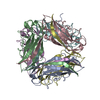 8psvC 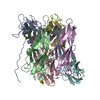 8ptuC M: atomic model generated by this map C: citing same article ( |
|---|---|
| Similar structure data |
- Links
Links
| EMDB pages |  EMDB (EBI/PDBe) / EMDB (EBI/PDBe) /  EMDataResource EMDataResource |
|---|
- Map
Map
| File |  Download / File: emd_10721.map.gz / Format: CCP4 / Size: 64 MB / Type: IMAGE STORED AS FLOATING POINT NUMBER (4 BYTES) Download / File: emd_10721.map.gz / Format: CCP4 / Size: 64 MB / Type: IMAGE STORED AS FLOATING POINT NUMBER (4 BYTES) | ||||||||||||||||||||||||||||||||||||||||||||||||||||||||||||
|---|---|---|---|---|---|---|---|---|---|---|---|---|---|---|---|---|---|---|---|---|---|---|---|---|---|---|---|---|---|---|---|---|---|---|---|---|---|---|---|---|---|---|---|---|---|---|---|---|---|---|---|---|---|---|---|---|---|---|---|---|---|
| Voxel size | X=Y=Z: 1.08187 Å | ||||||||||||||||||||||||||||||||||||||||||||||||||||||||||||
| Density |
| ||||||||||||||||||||||||||||||||||||||||||||||||||||||||||||
| Symmetry | Space group: 1 | ||||||||||||||||||||||||||||||||||||||||||||||||||||||||||||
| Details | EMDB XML:
CCP4 map header:
| ||||||||||||||||||||||||||||||||||||||||||||||||||||||||||||
-Supplemental data
-Mask #1
| File |  emd_10721_msk_1.map emd_10721_msk_1.map | ||||||||||||
|---|---|---|---|---|---|---|---|---|---|---|---|---|---|
| Projections & Slices |
| ||||||||||||
| Density Histograms |
-Additional map: #1
| File | emd_10721_additional_1.map | ||||||||||||
|---|---|---|---|---|---|---|---|---|---|---|---|---|---|
| Projections & Slices |
| ||||||||||||
| Density Histograms |
-Half map: #2
| File | emd_10721_half_map_1.map | ||||||||||||
|---|---|---|---|---|---|---|---|---|---|---|---|---|---|
| Projections & Slices |
| ||||||||||||
| Density Histograms |
-Half map: #1
| File | emd_10721_half_map_2.map | ||||||||||||
|---|---|---|---|---|---|---|---|---|---|---|---|---|---|
| Projections & Slices |
| ||||||||||||
| Density Histograms |
- Sample components
Sample components
-Entire : Type 1 pilus rod
| Entire | Name: Type 1 pilus rod |
|---|---|
| Components |
|
-Supramolecule #1: Type 1 pilus rod
| Supramolecule | Name: Type 1 pilus rod / type: complex / ID: 1 / Parent: 0 / Macromolecule list: all Details: Type 1 pili recombinantly expressed, assembled in vivo and subsequently purified from the E. coli cell surface. |
|---|---|
| Source (natural) | Organism:   Escherichia coli (E. coli) Escherichia coli (E. coli) |
| Molecular weight | Theoretical: 20.3 kDa/nm |
-Macromolecule #1: Type-1 fimbrial protein, A chain
| Macromolecule | Name: Type-1 fimbrial protein, A chain / type: protein_or_peptide / ID: 1 / Number of copies: 6 / Enantiomer: LEVO |
|---|---|
| Source (natural) | Organism:   Escherichia coli (E. coli) Escherichia coli (E. coli) |
| Molecular weight | Theoretical: 18.121074 KDa |
| Recombinant expression | Organism:   Escherichia coli str. K-12 substr. W3110 (bacteria) Escherichia coli str. K-12 substr. W3110 (bacteria) |
| Sequence | String: MKIKTLAIVV LSALSLSSTA ALAAATTVNG GTVHFKGEVV NAACAVDAGS VDQTVQLGQV RTASLAQEGA TSSAVGFNIQ LNDCDTNVA SKAAVAFLGT AIDAGHTNVL ALQSSAAGSA TNVGVQILDR TGAALTLDGA TFSSETTLNN GTNTIPFQAR Y FATGAATP GAANADATFK VQYQ UniProtKB: Type-1 fimbrial protein, A chain |
-Experimental details
-Structure determination
| Method |  cryo EM cryo EM |
|---|---|
 Processing Processing | helical reconstruction |
| Aggregation state | filament |
- Sample preparation
Sample preparation
| Concentration | 1.58 mg/mL |
|---|---|
| Buffer | pH: 7 / Details: in ddH2O. |
| Grid | Model: Quantifoil R1.2/1.3 / Material: COPPER / Mesh: 400 / Pretreatment - Type: GLOW DISCHARGE / Pretreatment - Time: 45 sec. / Pretreatment - Atmosphere: AIR |
| Vitrification | Cryogen name: ETHANE / Chamber humidity: 70 % / Chamber temperature: 277 K / Instrument: FEI VITROBOT MARK IV Details: 3 ul sample, 30 s wait time, 0.5 s drain time, 6 s blotting. |
- Electron microscopy
Electron microscopy
| Microscope | FEI TITAN KRIOS |
|---|---|
| Electron beam | Acceleration voltage: 300 kV / Electron source:  FIELD EMISSION GUN FIELD EMISSION GUN |
| Electron optics | C2 aperture diameter: 70.0 µm / Illumination mode: FLOOD BEAM / Imaging mode: BRIGHT FIELD Bright-field microscopy / Cs: 2.7 mm / Nominal defocus max: 3.5 µm / Nominal defocus min: 1.5 µm / Nominal magnification: 130000 Bright-field microscopy / Cs: 2.7 mm / Nominal defocus max: 3.5 µm / Nominal defocus min: 1.5 µm / Nominal magnification: 130000 |
| Sample stage | Specimen holder model: FEI TITAN KRIOS AUTOGRID HOLDER / Cooling holder cryogen: NITROGEN |
| Image recording | Film or detector model: GATAN K2 SUMMIT (4k x 4k) / Detector mode: COUNTING / Number grids imaged: 1 / Number real images: 3469 / Average exposure time: 8.0 sec. / Average electron dose: 50.4 e/Å2 |
| Experimental equipment |  Model: Titan Krios / Image courtesy: FEI Company |
- Image processing
Image processing
-Atomic model buiding 1
| Initial model | PDB ID: Chain - Chain ID: D / Chain - Source name: PDB / Chain - Initial model type: experimental model |
|---|---|
| Refinement | Space: REAL / Protocol: RIGID BODY FIT / Overall B value: 49.9714 / Target criteria: Correlation coefficient |
| Output model |  PDB-6y7s: |
 Movie
Movie Controller
Controller






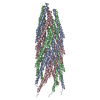
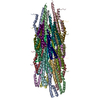
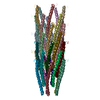
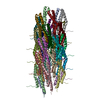

 Z
Z Y
Y X
X



































